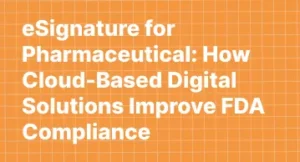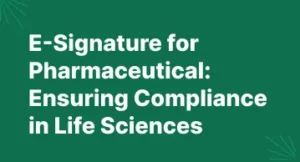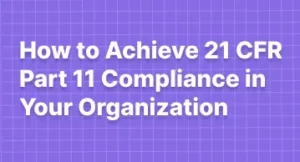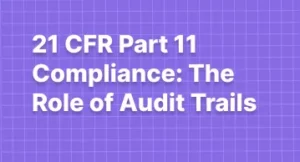Electronic Signature Contracts: What FDA Requires
Introduction
The shift from traditional wet signatures to electronic signatures (eSignatures) has transformed how businesses and regulated industries manage contracts and approvals. In highly regulated industries like pharmaceuticals and life sciences, compliance with 21 CFR Part 11 is crucial for ensuring the validity and security of digital records. The FDA (Food and Drug Administration) has established strict guidelines to ensure electronic signatures hold the same legal weight as handwritten ones. This article explores the differences between eSignatures and wet signatures, their impact on regulatory compliance, and what businesses need to know to meet FDA requirements. By leveraging Part 11-compliant Electronic Signature Contracts , companies can ensure compliance and streamline documentation processes.
Understanding Wet Signatures
A wet signature refers to a handwritten signature made using ink on paper. It has been the traditional method of signing documents for centuries and is often required for legal, financial, and governmental transactions. Despite its familiarity and acceptance, wet signatures come with several challenges, including:
- Time-consuming processes: Physical signing requires printing, mailing, and scanning, which can slow down workflows.
- Risk of document loss: Paper-based records are prone to misplacement, damage, or unauthorized alterations.
- Storage and retrieval difficulties: Physical storage requires space, and accessing older documents can be cumbersome.
What Are eSignatures?
Electronic signatures (eSignatures) are digital representations of a person’s agreement to a contract or document. They can be as simple as typing a name, using a stylus, or clicking an “I Agree” button. In FDA-regulated industries, 21 CFR Part 11 defines the criteria under which electronic records and eSignatures are considered trustworthy, reliable, and equivalent to wet signatures.
Benefits of eSignatures
- Speed and efficiency: Documents can be signed instantly from anywhere, eliminating delays.
- Security and traceability: Digital records must include an audit trail, reducing fraud risks.
- Cost savings: Reduces printing, shipping, and storage costs.
- Environmental benefits: Reduces paper waste, supporting sustainability efforts.
FDA Requirements for eSignatures (21 CFR Part 11)
To be compliant with 21 CFR Part 11, eSignatures must meet strict requirements to ensure the authenticity, integrity, and confidentiality of electronic records. The key requirements include:
Identity Verification
The FDA mandates that organizations using eSignatures must verify the identity of the signer through secure authentication methods, such as:
- Username and password combinations
- Biometric authentication (fingerprint, facial recognition)
- Multi-factor authentication (MFA)
Audit Trails
A compliant eSignature system must maintain an independent, computer-generated, time-stamped, unalterable audit trail, which tracks:
- The date and timestamp of the action
- The identity of the user performing the action
- A detailed description of the action, including old and new values of any data affected
Secure Data Storage
All electronically signed records must be securely stored with access controls in place to prevent unauthorized changes. Encryption and role-based permissions protect sensitive information.
Signature Linking
Each eSignature must be linked to the corresponding record to prevent tampering. This ensures that signatures cannot be removed, copied, or transferred fraudulently.
eSignatures vs. Wet Signatures: Which One Should You Use?
Choosing between eSignatures and wet signatures depends on the type of document, industry regulations, and specific business needs. Here’s a quick comparison:
| Feature | Wet Signatures | eSignatures |
|---|---|---|
| Legally Binding? | Yes | Yes, if compliant with 21 CFR Part 11 |
| Security | Security | Encrypted, locked with tamper-evident seal |
| Audit Trail | None or manually maintained | Independent, computer-generated, time-stamped, and unalterable log that records all user actions |
| Speed | Slow due to physical handling | Instant, digital process |
| Storage | Requires physical space | Cloud-based and easily retrievable |
| Environmental Impact | Paper-intensive | Eco-friendly, reduces waste |
How MSB Docs Ensures FDA Compliance
MSB Docs provides a fully validated, 21 CFR Part 11-compliant eSignature solution designed for pharmaceuticals, biotech, and life sciences industries. With robust security features, MSB Docs ensures:
- End-to-end encryptio n for data security.
- Advanced identity verificatio n for signer authentication.
- Comprehensive audit trails to track document modifications.
- Automated workflows to streamline regulatory document approvals.
Internal Linking
For businesses looking to streamline their electronic documentation processes while staying compliant, refer to our comprehensive 21 CFR Part 11 eSignature Compliance Checklist: What You Need to Know About FDA Regulations (Updated) to ensure full regulatory adherence.
Conclusion
The debate between eSignatures and wet signatures boils down to efficiency, security, and compliance. While wet signatures still hold significance in some industries, Part 11-compliant eSignatures provide a faster, more secure, and legally recognized alternative —especially in regulated environments. Adopting MSB Docs’ eSignature solution ensures organizations in highly regulated industries meet compliance standards while improving efficiency and reducing paperwork. Transitioning to electronic signature contracts is not just about convenience—it’s about staying ahead in an increasingly digital world.







